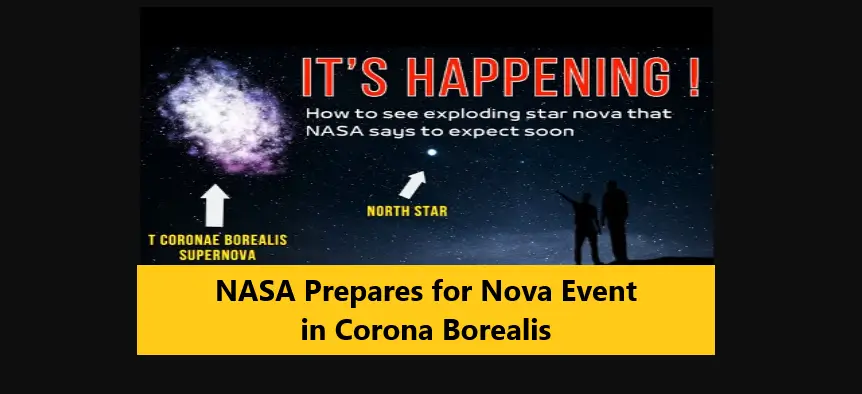NASA Prepares for Nova Event in Corona Borealis
NASA Prepares for Nova Event in Corona Borealis.
Astronomers Anticipate Spectacular Nova Explosion in Corona Borealis
Astronomers and space enthusiasts worldwide are eagerly awaiting a rare celestial event unfolding in the night sky on Monday.
Scientists at the National Aeronautics and Space Administration (NASA) expect a rare nova explosion in the constellation Corona Borealis, promising a spectacular show for observers.
Read More: NASA’s Parker Mission to Make Solar Landing in 2024
Event Timing and Significance
The event is anticipated between Monday night and September. This rare nova explosion offers a unique opportunity for both seasoned astronomers and newcomers to witness a cosmic phenomenon up close. An assistant research scientist specializing in nova events at NASA described the event as a “once-in-a-lifetime” occurrence.
What is T Coronae Borealis?
The nova, known as “T Coronae Borealis” or “Blaze Star,” is approximately 3,000 light-years away.
This celestial event involves a white dwarf, the remnant of a dead star, and an aging red giant star.
The interaction between these stars leads to periodic explosions called novae, distinct from catastrophic supernovae marking the deaths of massive stars.
The Science Behind Novae
Unlike supernovae, which often destroy the star, novae involve a sudden, intense release of energy from the white dwarf.
This occurs when hydrogen from the red giant accumulates on the white dwarf’s surface, triggering a runaway thermonuclear reaction.
The accumulated material is ejected into space in a luminous burst, significantly increasing the star’s brightness temporarily.
Historical Context and Anticipation
T Coronae Borealis has a history of periodic eruptions, with the last notable event occurring in 1946.
The upcoming nova event has been eagerly awaited due to its proximity, offering an unprecedented opportunity for observation and study.
Scientific Exploration and Observation
Scientists hope to study the nova across various wavelengths, from visible light to gamma rays, using a constellation of ground-based and space-based telescopes.
Notable instruments include NASA’s Fermi Gamma-ray Space Telescope and the James Webb Space Telescope.
Participation from Amateur Astronomers
The nova’s visibility to the naked eye makes it accessible for amateur astronomers, who are encouraged to observe and contribute data during the event.
Their contributions through social media and collaborative platforms are important in enhancing humanity’s understanding of these cosmic phenomena, as per NASA.
Locating Corona Borealis
Corona Borealis, where the nova will occur, can be located west of the Hercules constellation.
The constellation is recognizable by its horseshoe shape and can be spotted under clear night skies between the bright stars Arcturus and Vega.
Key Points to Remember
- Event Timing: Expected between Monday night and September
- Key Participants: NASA, amateur astronomers, global space agencies
- Significance: A rare, “once-in-a-lifetime” nova explosion
- Instruments: Fermi Gamma-ray Space Telescope, James Webb Space Telescope
- Visibility: Naked eye visibility for easy observation
This rare nova explosion in Corona Borealis presents a unique opportunity for both professional and amateur astronomers to observe a spectacular celestial event.
With significant contributions from NASA and other space agencies, this event promises to enhance our understanding of cosmic phenomena.
Stay tuned and prepare your telescopes for this incredible display in the night sky.
For more information on celestial events and updates, visit NASA’s official website.
Note: The information above might not be accepted 100%. Please verify from your own sources. We will not be responsible for any kind of loss due to our content.
For more news, please visit Munafa Marketing.




